|

Special Issue
Treasures from Banks, OR
Fall, 2004
Back to HOMEPAGE
page
1 | page 2 | page 3 |
page 4 | page 5
| page 6 | page 7
| From the Geigers, October 29:
Went for a short walk. More pictures for you. The fat one with the quarter may be the same as the one we sent to
Amanitarita.
The next picture is an update on the one you thought was a Dead
Man's Hand.
The next picture I think is a Russula. Thought it would make a good picture.
The little one with the Chanterelle I don't have a cure. Just looked neat.
|
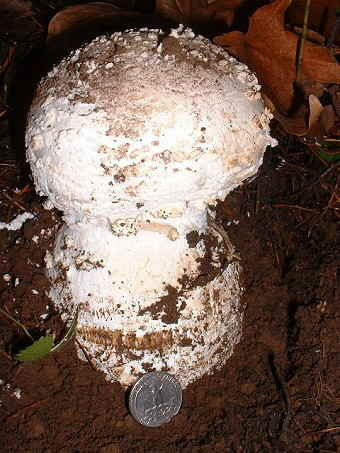 |
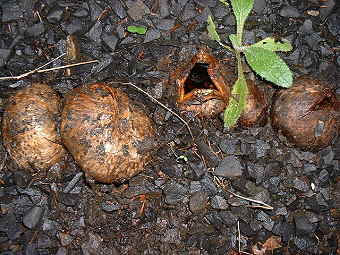 |
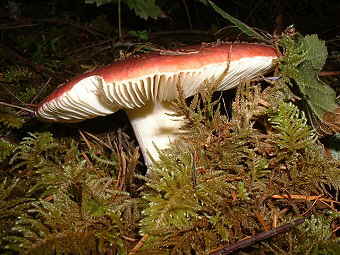 |
|
From me:
More nice pictures. I am trying
to check the identity of the beautiful little mushroom with the
shaggy stalk, but I think it is a Lepiota clypeolaria or
Lepiota
magnispora (at Mykoweb.com). Here is a picture link to the
magnispora: http://www.mykoweb.com/CAF/photos/
Lepiota_magnispora(bk-01).jpg
The ugly ones next to the Red Russula I am pretty sure are
the Dead Man's Hand, or Scleroderma geaster.
Please keep those nice pictures
coming!
|
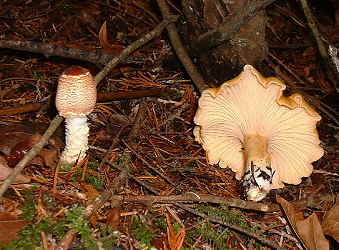 |
|
From Fred Stevens:
Hi Herman-
I think your ID's are reasonable, but
you might consider sending the Lepiota picture to Else Vellinga
for confirmation, since she's the expert in the field.
Fred
From the Geigers, October 30:
This one is open a bit more than the first. Will watch and get more pictures.
I can't believe the volume of mushrooms that are coming up. Either I just never paid much attention or it is a very good year for them.
From Else Vellinga:
Hi Herman,
The really dark contrasting centre gives yours away as definitely
not L. clypeolaria. To be more positive, it is either
L. magnispora, or L. spheniscispora (the one David Arora calls
L. clypeolaria var. nabiscodisca).
|
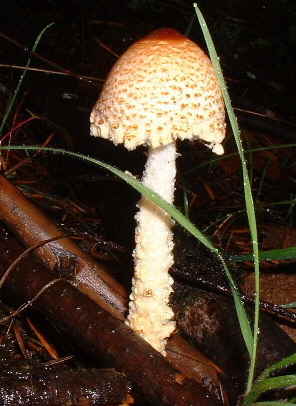 |
|
The differences between L.
magnispora and L. spheniscispora (sorry, but I
concocted this name, which means penguin-spores) is harder; the
colours of L. spheniscispora are more yellow-brown, whereas
L. magnispora has that chestnut brown centre.
Microscopically there is no
difference, as far as I could tell. Both have those penguin
spores, which is different from the spores of L. clypeolaria.
There is a good difference in the ITS-region of the DNA, but that
is harder to see.....
Where did you find yours?
I know that L. spheniscispora has
been found in the oak woodlands of the Sierra foothills. Higher up
I expect L. magnispora, which is probably also more northern than
L. spheniscispora.
We find L. magnispora in
Mendocino Co., whereas the other one is the more common in the
Bay area.
A long story, and no definite
answer; my inclination is to call yours L. spheniscispora,
but to be really sure, I'd like to have an ITS sequence.
Thanks for sharing this with me!
All the best and yes, we should definitely not forget how pretty
these mushrooms are!
Else
More from Else Vellinga:
Herman, just now I see that you found them in Oregon -
that makes it more likely that it is L. magnispora.
Sorry for the confusion,
Else
|
| From the Geigers, October 31:
Herman, Here
is a picture of the Lepiota in two different stages. I checked a different area and found quite a number of them.
I don't don't know if this year has been wetter than normal, but the rain started about a month earlier than the last few years.
|
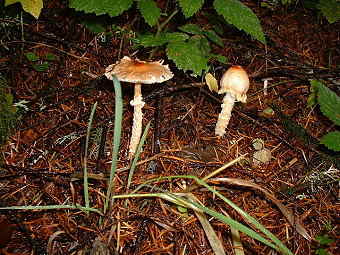
Lepiota magnispora |
|
I have some other pictures I took today, a bit of everything.
Sun is out today at times but there is a chill in the air.
Later,
Bob
|
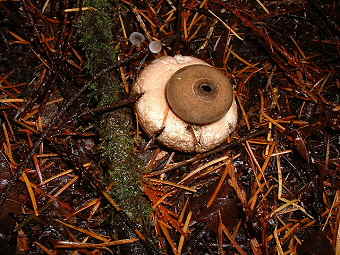 |
|
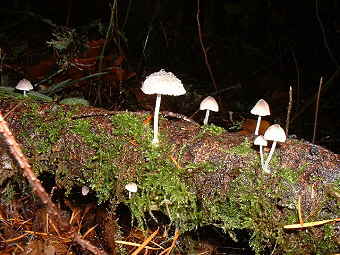
|
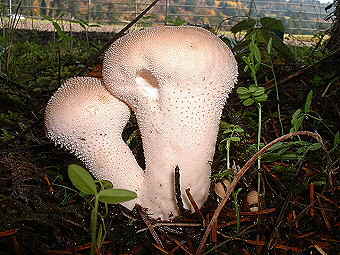 |
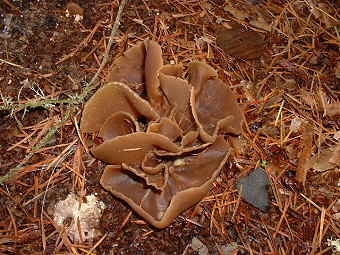 |
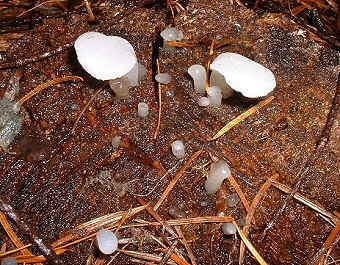 |
|
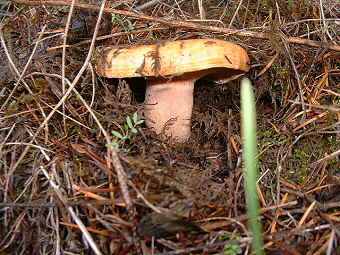
|
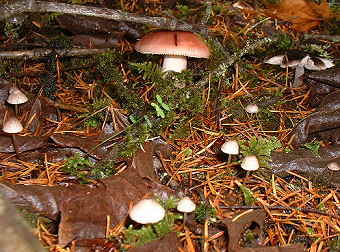
|
|
From me:
The Earthstar looks like a
Geastrum saccatum
The puffballs after the tiny white
mushrooms may be a Lycoperdon pyriforme. The one after the brown cup fungus looks like a Toothed Jelly Fungus, or
Pseudohydnum gelatinosum.
You should pick one and take a close-up of the underside of the "cap".
The next one looks looks like a Lactarius, which means it should
bleed latex. If the latex is orange, it would be a Lactarius
deliciosus, if it is red, it would be a L. rubrilacteus.
|

|
|
If the latex is yellow or white, you will have to look in the book, but taste a small piece first and you may have to spit it out fast because it could be VERY bitter or hot.
The next one is another Russula,
probably an emetica.
The last one looks like a Crested
Coral or Clavulina cristata.
More from me (in regard to the
Lactarius):
Sometimes you will see the latex droplets when you scratch the gills, but when you break it in half, you should see some red latex coming to the surface and even if not, it should stain a piece of white paper red, and not carrot-colored like it would be with the deliciosus.
The rubrilacteus is supposed to be better tasting than the deliciosus, according to David Arora's sources.
Some of old-timers in Greenville used to call them the Sanguines, and I think Ruth
Styer still does herself.
It used to be named the Lactarius
sanguifluus, where the common name probably came from, but through the years, both the orange-latexed one and the red-latexed one have been called
Sanguines.
Both will also stain green with
age, require long and slow cooking, and are usually used in stews. From
the Geigers:
The Lactarius stained red. |
| From the Geigers, November 1:
Wow! I was walking to the parking garage in downtown Portland, when I saw a large mushroom that I figured had to be some kind of Bolete. So I picked it, figuring to come home and look it up. Later, when I was going back from the garage to my office, I saw what I thought might be a Chanterelle down along the edge of the grass. Got down there and investigated, and it was not a Chanterelle, but I started to look around, and I found Boletes all over the place! Some of them are kind of old, but there are lots of young ones too. Picked a big bag full, and we will have a feast tonight. Looks like a King Bolete to me - what do you think? Bob looked in the All the Rain Promises book, and he thinks it might be a Birch Bolete. These were growing in the lawn and ivy, under some kind of deciduous tree. Also, the stalks have the dark scales associated with the Birch Bolete. Anyway, we will have a feast tonight!
I did not notice any bruising when cut. The cap is a dark
tan to tannish-grey color on all of them. The ones that had the bulbous base were the smaller ones - the younger the
mushroom, the fatter the base. Cooked some up tonight and had a few. Will let you know tomorrow how we feel, but I'm sure from looking in David's books that we have no great fears.
Rebecca
From me:
It does sound like the Leccinum scabrum, or Birch Bolete. Do you have Mushroom
Demystified? If not, the site for Dr. Michael Kuo might be very helpful, as he lives closer to you than
David Arora.
|
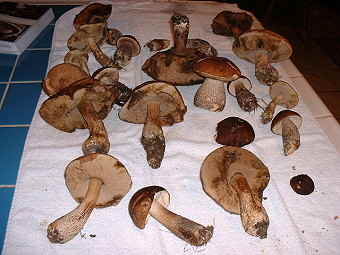
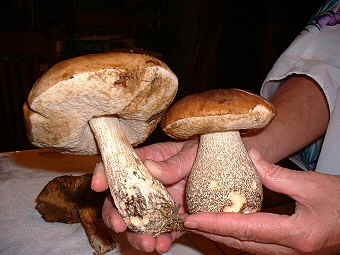
|
|
His mushroom site is www.mushroomexpert.com.
The pull-down list of keys is on the middle right side of the first screen.
I met him through his wanting to use one of my morel pictures for his upcoming book, "Morels".
I have never found nor eaten a Leccinum.
How did they taste?
From the Geigers, November 3:
They
tasted real good. Kind of of a nutty taste. I ate the ones she
cooked in butter. She also cooked some in Chicken broth, but I did
not try them.
Robert
|
< previous page | next
page >
Back to HOMEPAGE
|